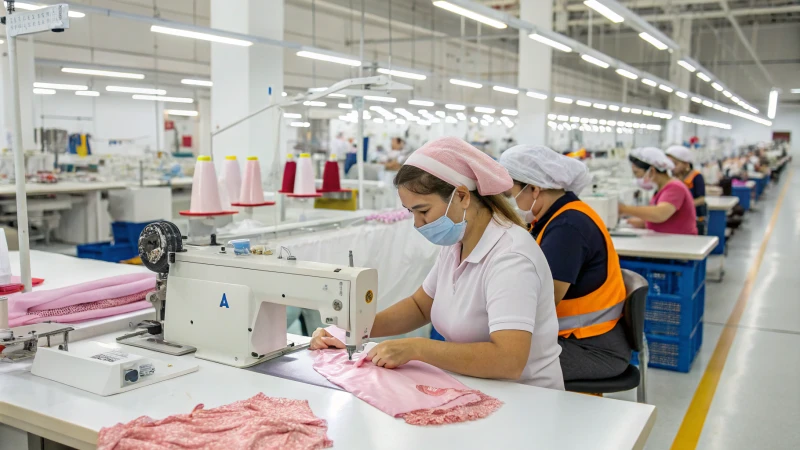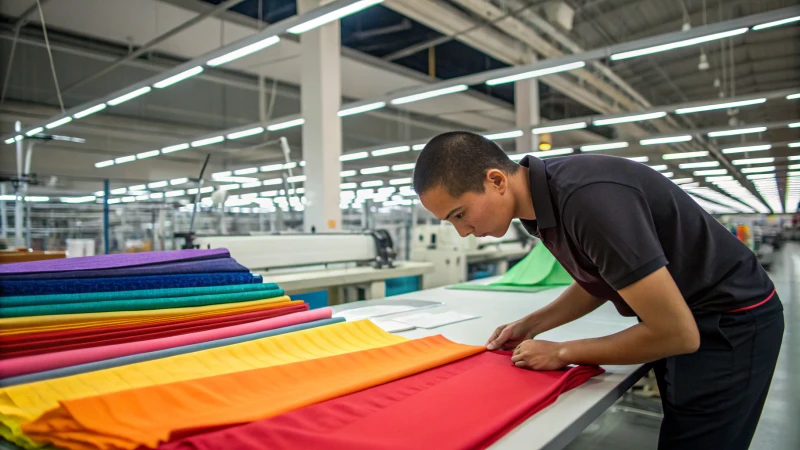
Ever wondered how a well-trained team can elevate your underwear game?
Workforce training significantly enhances underwear quality by honing workers' skills, minimizing production mishaps, and sparking innovation. With training, employees manage delicate fabrics skillfully, catch defects early, and embrace new materials or techniques, consistently upholding high-quality standards.
Reflecting on my own journey, I've seen firsthand how investing in workforce training can revolutionize the production floor. It’s like seeing your favorite band live—the precision, the synchronicity, it's all a result of practice and skill-building. When workers are trained to handle fabrics gently yet effectively, the difference in the final product is palpable. It's not just about learning new techniques; it's about mastering the art of stitching with finesse and ensuring every piece meets an uncompromising standard of quality. So, if you're wondering whether it’s worth it to invest in your team’s development, think about the incredible satisfaction of offering a product that stands out for its craftsmanship and durability.
Training reduces underwear production errors by 50%.True
Workforce training improves skills, cutting errors significantly.
Untrained workers adapt faster to new materials.False
Trained workers adapt more quickly due to enhanced skills.
What Are the Key Skills Needed for High-Quality Underwear Production?
Navigating the intricate world of lingerie production feels like a delicate dance between art and precision. It's about more than just fabric and stitches—it's about crafting comfort and confidence.
The key skills for high-quality underwear production include proficiency in fabric selection, precise sewing techniques, understanding of design principles, and stringent quality control. These skills ensure durability, comfort, and style.

Fabric Selection
When I first ventured into the world of underwear production, I learned that fabric selection is like choosing the right canvas for a masterpiece. Each material has its own story—cotton whispers of comfort and absorbency1, while spandex sings of flexibility and fit. Knowing these properties isn't just technical; it's about feeling the fabric in your hands and imagining the end result.
Sewing Techniques
There's a particular joy in mastering sewing techniques. I remember the satisfaction of creating a seamless finish with delicate fabrics, ensuring each piece not only fits well but stands the test of time. Overlocking and flatlock stitching are my go-to techniques for reinforcing seam strength2. It's like crafting a hidden backbone in every pair of underwear.
Design Principles
Balancing aesthetics with functionality is an art in itself. I often find inspiration in the challenge of incorporating intricate lace3 or bold patterns without sacrificing comfort. Keeping up with fashion trends and listening to consumer preferences allows me to create designs that not only look good but feel even better to wear.
Quality Control
I can still recall my early days on the production floor, learning to spot imperfections with an eagle eye. Implementing stringent quality control is crucial, as it helps catch defects early and maintain high standards. Each piece that passes through my hands is a testament to diligence and care.
Ongoing Training and Innovation
Staying ahead in this industry means never stopping learning. Attending workshops and training sessions keeps my skills sharp and ready to adapt to new market changes4. This continuous education isn't just about meeting demands—it's about pushing boundaries and redefining what high-quality underwear can be.
| Skill | Importance |
|---|---|
| Fabric Selection | Ensures comfort and durability |
| Sewing Techniques | Maintains fit and structure |
| Design Principles | Balances style with function |
| Quality Control | Detects defects early |
| Training & Innovation | Keeps pace with trends |
Understanding these skills has been pivotal in my journey, not just for enhancing production quality but also for ensuring customer satisfaction and building a brand reputation that stands out in the competitive lingerie market.
Cotton is the most breathable fabric for underwear.True
Cotton is renowned for its breathability, making it ideal for comfort.
Overlocking is rarely used in underwear production.False
Overlocking is a common sewing technique to enhance seam strength.
How Can Training Programs Transform Manufacturing and Reduce Errors?
Have you ever wondered how a simple training session could transform an entire manufacturing process? Dive into the world of training programs and discover their incredible impact on reducing errors.
Training programs reduce manufacturing errors by enhancing worker skills, ensuring consistency, and promoting quality control. By educating employees on new techniques and materials, these programs enable better handling of tasks, leading to fewer defects and improved product quality.

The Role of Skill Enhancement
I remember the first time I saw the real impact of a training program. It was during a chaotic production run, where errors seemed more common than successes. Our company decided to invest in a comprehensive training module focused on skill enhancement. Watching our workers gain confidence as they learned to maneuver new machinery was like witnessing a small miracle. They began to execute their tasks with precision, and the production line ran smoother than ever before. This experience taught me that skill development is more than just learning—it’s about empowering people to excel.
Training programs are pivotal in enhancing the skills of manufacturing workers. By providing hands-on experience with machinery and advanced technologies5, employees become more adept at executing their tasks with precision. This skill development reduces human errors and ensures that production lines run smoothly.
Consistency Through Standardization
Once, during a particularly challenging project, I realized the power of standardization. We had implemented standardized training protocols across our teams, which significantly minimized variations in task execution. As everyone received the same level of training, the process consistency was evident. This uniformity is crucial in manufacturing, where even the smallest deviation can lead to significant errors.
Standardized training protocols help maintain consistency across the workforce. When all employees receive the same level of training, it minimizes variations in how tasks are performed.
| Training Element | Impact on Errors |
|---|---|
| Skill Development | Reduces human error |
| Standardized Procedures | Ensures consistency |
| Quality Control Education | Detects flaws early |
Promoting Quality Control Awareness
There was a moment when I truly understood the value of quality control education. During a training session focused on detecting defects early, I watched as our team learned to spot potential issues before they escalated. This proactive approach led to higher product standards, and the pride our workers took in maintaining quality was palpable.
Educating workers on the importance of quality control can significantly lower error rates. Training sessions focused on detecting defects early in the production process empower employees to identify potential issues before they escalate. This proactive approach leads to higher product standards6.
Adoption of New Techniques
Staying updated with industry advancements was once a daunting task for us. However, ongoing education about new manufacturing techniques and materials turned this challenge into an opportunity for innovation. Training allowed our team to adapt swiftly and efficiently to novel challenges and equipment.
Ongoing education about new manufacturing techniques and materials fosters innovation. Training allows workers to stay updated with industry advancements, enabling them to adapt swiftly and efficiently.
Real-World Applications
Implementing continuous training models has been nothing short of transformative for us. For instance, integrating regular skill assessments and feedback loops into our training programs has led to noticeably lower defect rates.
Implementing a continuous training model can yield significant results. Companies that have integrated regular skill assessments and feedback loops into their training programs report lower defect rates.
Evaluating performance and addressing gaps promptly have helped maintain a high level of efficiency.
Consider exploring resources on effective training methodologies7 to further enhance your workforce's capabilities.
Training reduces human error in manufacturing.True
Training enhances skills, leading to fewer errors and smoother production.
Standardized training increases task variation.False
Standardized training ensures uniformity, reducing task performance variations.
Why Is Ongoing Education Vital in Underwear Manufacturing?
Imagine being part of a world where every stitch tells a story, and every fabric choice changes the game. That's the reality in underwear manufacturing, where ongoing education is the key to innovation.
Ongoing education in underwear manufacturing sharpens skills, minimizes errors, and fuels innovation. By embracing new techniques and materials, manufacturers ensure top-notch quality and satisfy evolving customer preferences.

Enhancing Skill Levels
In my journey through the underwear manufacturing industry, I've learned that ongoing education is like having a secret weapon. Regular training sessions are not just about learning the ropes; they're about mastering the art of handling those delicate fabrics and nailing those precise stitches. Think of it like leveling up in a video game—every skill upgrade means fewer mistakes and a better overall quality8 product.
Reducing Errors and Ensuring Consistency
When I first started, I remember the anxiety of spotting a mistake after production. But with ongoing education, it felt like having an extra set of eyes. The training helps us spot flaws early, turning potential disasters into triumphs. This knack for early detection cuts down on errors and boosts efficiency9, making the whole process smoother.
| Benefits of Ongoing Education | Impact on Manufacturing |
|---|---|
| Improved Skills | Better craftsmanship |
| Error Reduction | Fewer defects |
| Innovation | Adaptation to new trends |
Fostering Innovation
Staying updated with the latest materials and techniques feels like being on the cutting edge of fashion technology. I recall a training session where we explored a new fabric—it was a game-changer. These insights open doors to innovations that keep us ahead in meeting consumer demands for modern, high-quality products.
Meeting Changing Consumer Demands
Consumers today want it all—comfort, style, sustainability. With ongoing education, we can deliver just that. I once worked on a project using advanced sewing techniques that transformed our designs into must-haves for fashion-forward customers. Training equips us to keep up with these trends, ensuring customer satisfaction10 by making products that resonate with what people really want.
Ongoing education reduces production errors in underwear manufacturing.True
Training enhances skills, leading to fewer mistakes in production.
Innovation in underwear design is unrelated to ongoing education.False
Education helps workers adapt to new trends, fostering innovation.
How Have Lingerie Brands Mastered Workforce Training?
Have you ever wondered what goes into creating those delicate lingerie pieces we love so much? Let's dive into the stories behind the seams and see how top brands elevate their workforce.
In the lingerie industry, successful workforce training focuses on developing skills in fabric handling and quality control. Brands like Victoria's Secret and Aerie have crafted programs that boost employee expertise, ensuring exceptional product quality and heightened customer satisfaction.

Victoria's Secret: Pioneering Training Initiatives
I remember my first day at a lingerie factory—nervous but excited. Victoria's Secret has made it a mission to transform such initial jitters into expertise through their training initiatives. They've established hands-on workshops and virtual training that not only teach employees about fabric quality11 but also help them master the art of precision sewing. I can still recall the pride of nailing those intricate stitches during a workshop.
Training Methods Employed
- Hands-On Workshops: Engaging in practical sessions, I learned advanced stitching and quality control, which was both challenging and rewarding.
- Virtual Training: Their online modules introduced me to the latest trends, allowing for flexible and continuous learning.
| Training Focus | Methodology |
|---|---|
| Fabric Quality | Workshops, Virtual Modules |
| Precision Sewing | Hands-On Practice |
Aerie: Embracing Innovation
Meanwhile, Aerie has embraced innovation with a flair that resonates with my tech-loving heart. By incorporating virtual reality12 simulations, they’ve provided employees with immersive experiences that make learning feel like an adventure. Imagine virtually trying your hand at delicate lace without wasting a single thread!
Key Benefits
- Realistic Simulations: These offer an engaging way to learn without fear of making mistakes.
- Error Reduction: By practicing in a risk-free environment, employees enhance product quality through fewer mistakes.
Emphasizing Continuous Learning
Both brands emphasize that learning never stops. Regular updates on new materials and techniques mean we're always on the cutting edge, aligning our skills with consumer expectations. I’ve found this continuous education keeps us competitive and motivated.
Future Directions
As the industry continues to evolve, I foresee even more integration of AI-driven tools13. These tools promise to further streamline training processes, enhancing our skill sets and boosting efficiency. It's an exciting time to be part of such a dynamic field!
Whether you're just starting or are a seasoned artisan, these programs offer a pathway to excellence in the art of lingerie making. So let's continue crafting stories through every stitch and seam, ensuring that each piece is as perfect as it can be.
Victoria's Secret uses virtual reality in training.False
Victoria's Secret uses virtual training modules, not virtual reality.
Aerie's training reduces material wastage risk.True
Aerie uses virtual reality to simulate handling, reducing wastage.
Conclusion
Workforce training enhances underwear quality by improving skills, reducing errors, and fostering innovation. Trained employees ensure high standards in fabric handling, stitching precision, and quality control.
Explore why cotton is preferred for its comfort and absorbency in underwear production. ↩
Learn about sewing techniques that enhance durability and seam strength. ↩
Discover methods to include lace in designs while maintaining comfort. ↩
Understand the role of continuous learning in adapting to market changes. ↩
Explore how integrating advanced technologies in training enhances workforce skills, leading to reduced errors and improved efficiency. ↩
Understand why quality control is critical in manufacturing and how it helps prevent defects, ensuring high product standards. ↩
Discover effective methodologies for manufacturing training that improve worker performance and minimize errors. ↩
Discover how a skilled workforce enhances product quality and reduces manufacturing defects. ↩
Learn why minimizing errors is critical for maintaining high production standards. ↩
Explore how innovative practices contribute to higher levels of customer satisfaction. ↩
Explore how Victoria's Secret's focus on fabric quality has improved production standards through effective training methods. ↩
Learn about Aerie's innovative use of virtual reality in employee training to enhance realism and effectiveness. ↩
Discover how AI-driven tools are revolutionizing workforce training by improving efficiency and personalization. ↩






